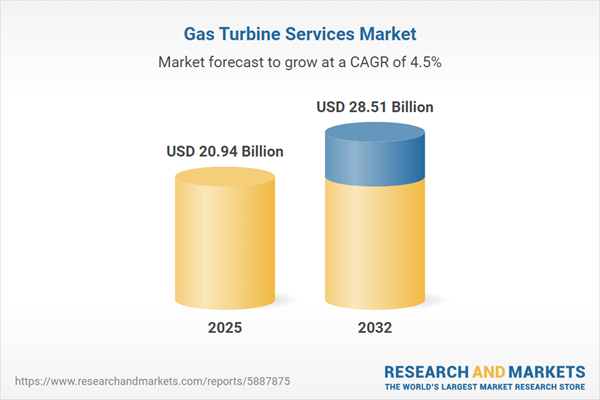Speak directly to the analyst to clarify any post sales queries you may have.
The gas turbine services market is pivotal for organizations striving to adapt operations for greater efficiency, compliance, and resilience in today’s energy sector. Senior leaders are leveraging advanced maintenance strategies to align with technological evolution and sustainable business practices.
Market Snapshot: Gas Turbine Services Market
The global gas turbine services market continues to expand as industries prioritize digital transformation, sustainable operations, and streamlined asset management. Revenues for the sector are projected to reach USD 28.51 billion by 2032, up from USD 20.04 billion in 2024, representing a 4.50% CAGR. This growth is fueled by the adoption of digital analytics and predictive maintenance tools, which are shaping how industrial equipment is managed amid tightening regulatory standards. Firms are adopting more sophisticated service offerings, providing operators with strategies to address compliance trends and optimize resource utilization for long-term resilience.
Scope & Segmentation
This report delivers actionable analysis designed for senior executives evaluating opportunities and investment in the gas turbine services space. The research breaks down the market into critical operational segments essential for strategic planning:
- Service Type: Encompasses preventive maintenance, predictive analytics, thermography, vibration diagnostics, emergency repair, and surface restoration, each contributing to asset uptime, safety, and lifecycle extension.
- End User: Evaluates industry-specific requirements for steel production, cement manufacturing, pulp and paper, marine transport, oil and gas, as well as power generation, reflecting distinct technical standards and regulations.
- Turbine Type: Analyzes the demands across aeroderivative turbines—which offer flexible, rapid-response applications—and heavy-duty frame turbines, including popular models like Frame 5, Frame 6, and Frame 7.
- Power Rating: Assesses service and maintenance approaches for turbines spanning under 20 MW, mid-range 20–50 MW, and large-scale above 50 MW capacities to address varying operational requirements.
- Service Model: Outlines the spectrum of long-term agreements, performance-based contracts, and spot service options, supporting diverse risk profiles and budget strategies.
- Regional Coverage: Details market trends in the Americas, Europe, Asia-Pacific, and Middle East and Africa, with in-depth perspectives for the United States, Germany, Japan, China, Saudi Arabia, and South Africa to address regional priorities and policies.
- Company Coverage: Benchmarks leading industry players such as General Electric Company, Siemens Energy AG, Mitsubishi Power, Baker Hughes Company, Solar Turbines Incorporated, and Ansaldo Energia S.p.A. to aid comprehensive supplier evaluation and strategic alignment.
Key Takeaways for Senior Executives
- Digital solutions, including AI-powered monitoring and predictive platforms, are enabling a proactive approach to maintenance, helping mitigate downtime and improve equipment value.
- Integration of sustainability practices, such as hydrogen-ready technologies and decarbonization initiatives, is increasingly important to meet evolving regulatory and environmental standards.
- Emphasis on local supply chains and logistics is strengthening business continuity, ensuring prompt service delivery and reducing exposure to international disruptions.
- Tailored service agreements allow organizations to precisely address the technical, operational, and compliance needs unique to each industrial segment.
- Responding swiftly to regional regulatory shifts and adoption rates allows firms to maintain a competitive edge and allocate investments effectively for expansion or diversification.
- Adoption of integrated digital systems and flexible contract frameworks facilitates more agile responses to future operational and market complexities.
Tariff Impact and Supply Chain Considerations
Recent tariff adjustments in the United States are prompting service providers to increase collaboration with domestic partners and boost investment in localized repair capabilities. As a result, outcome-based service contracts are growing in use, supporting organizations in managing uncertainties within the supply chain while maintaining consistent service quality.
Methodology & Data Sources
This report relies on structured secondary research, national data validation, expert interviews, and verified company disclosures, combined via thorough triangulation. These measures ensure the findings are reliable, unbiased, and tailored for gas turbine services market leaders.
Why This Gas Turbine Services Market Report Matters
- Empowers decision-makers to align technology investments and service models with evolving operational objectives and risk environments.
- Supports competitive intelligence and supplier selection by providing actionable insights and benchmarking relevant to regulatory and technological shifts.
- Equips leaders with adaptable strategies to navigate market complexity, regulatory change, and opportunities arising from digitalization and sustainability initiatives.
Conclusion
Armed with thorough insights, executives are prepared to drive operational improvements, adapt to changing market forces, and ensure their organizations remain agile and responsive in the gas turbine services sector.
Additional Product Information:
- Purchase of this report includes 1 year online access with quarterly updates.
- This report can be updated on request. Please contact our Customer Experience team using the Ask a Question widget on our website.
Table of Contents
3. Executive Summary
4. Market Overview
7. Cumulative Impact of Artificial Intelligence 2025
Companies Mentioned
The companies profiled in this Gas Turbine Services market report include:- General Electric Company
- Siemens Energy AG
- Mitsubishi Power, Ltd.
- Baker Hughes Company
- Solar Turbines Incorporated
- Ansaldo Energia S.p.A.
- Doosan Enerbility Co., Ltd.
- MAN Energy Solutions SE
- Kawasaki Heavy Industries, Ltd.
- MTU Maintenance Berlin-Brandenburg GmbH
Table Information
| Report Attribute | Details |
|---|---|
| No. of Pages | 194 |
| Published | October 2025 |
| Forecast Period | 2025 - 2032 |
| Estimated Market Value ( USD | $ 20.94 Billion |
| Forecasted Market Value ( USD | $ 28.51 Billion |
| Compound Annual Growth Rate | 4.5% |
| Regions Covered | Global |
| No. of Companies Mentioned | 11 |









